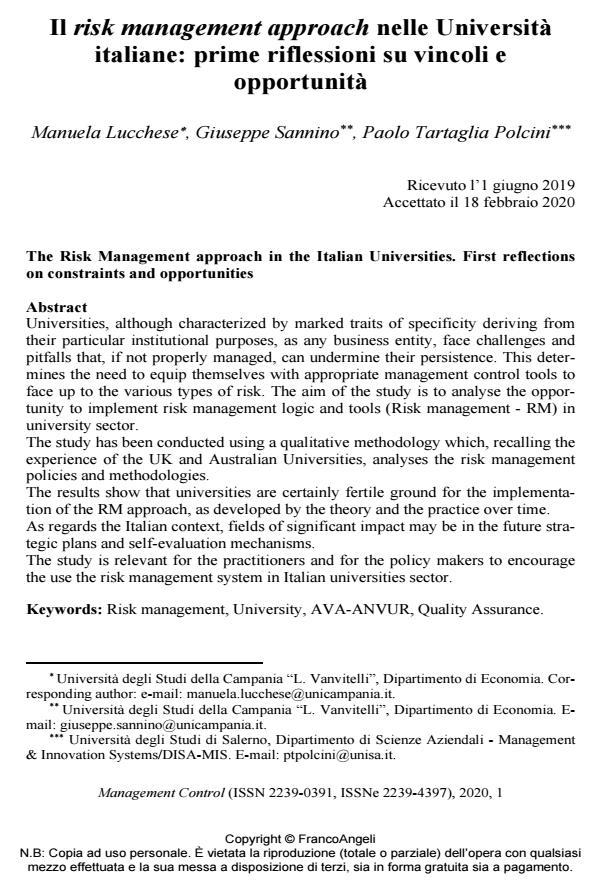The Risk Management approach in the Italian Universities. First reflections on constraints and opportunities
Journal title MANAGEMENT CONTROL
Author/s Manuela Lucchese, Giuseppe Sannino, Paolo Tartaglia Polcini
Publishing Year 2020 Issue 2020/1
Language Italian Pages 26 P. 111-136 File size 273 KB
DOI 10.3280/MACO2020-001006
DOI is like a bar code for intellectual property: to have more infomation
click here
Below, you can see the article first page
If you want to buy this article in PDF format, you can do it, following the instructions to buy download credits

FrancoAngeli is member of Publishers International Linking Association, Inc (PILA), a not-for-profit association which run the CrossRef service enabling links to and from online scholarly content.
Universities, although characterized by marked traits of specificity deriving from their particular institutional purposes, as any business entity, face challenges and pitfalls that, if not properly managed, can undermine their persistence. This deter-mines the need to equip themselves with appropriate management control tools to face up to the various types of risk. The aim of the study is to analyse the oppor-tunity to implement risk management logic and tools (Risk management - RM) in university sector. The study has been conducted using a qualitative methodology which, recalling the experience of the UK and Australian Universities, analyses the risk manage-ment policies and methodologies. The results show that universities are certainly fertile ground for the implementa-tion of the RM approach, as developed by the theory and the practice over time. As regards the Italian context, fields of significant impact may be in the future strategic plans and self-evaluation mechanisms. The study is relevant for the practitioners and for the policy makers to encourage the use the risk management system in Italian universities sector.
Keywords: Risk management, University, AVA-ANVUR, Quality Assurance.
- The Role of Citizens in the Municipalities' Risk Management Process: An Overview in Italy Monia Castellini, Vincenzo Riso, in MANAGEMENT CONTROL 1/2023 pp.143
DOI: 10.3280/MACO2023-001007 - The national culture as a determinant of ERM quality: Empirical evidence in the European banking context Alessandra Allini, Raffaela Casciello, Marco Maffei, Martina Prisco, in MANAGEMENT CONTROL 1/2022 pp.79
DOI: 10.3280/MACO2022-001006
Manuela Lucchese, Giuseppe Sannino, Paolo Tartaglia Polcini, Il risk management approach nelle Università italiane: prime riflessioni su vincoli e opportunità in "MANAGEMENT CONTROL" 1/2020, pp 111-136, DOI: 10.3280/MACO2020-001006